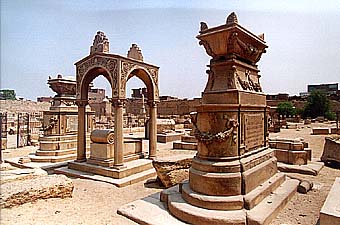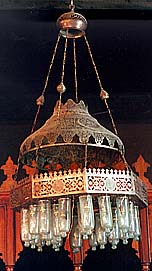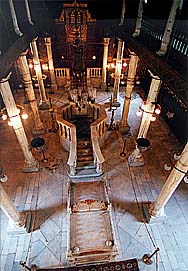A Common History
By; Sahar El-Bahr - Photos: Khaled El Fiki
http://www.ahram.org.eg/weekly/1999/446/tr1.htm
 The artefacts and monuments used by Egypt's Jews are part of our national heritage. They tell the story of the Jewish community in Egypt over the centuries." This is how Mohsen Abdel-Rahman Rabi', director of the Department of Jewish Antiquities (DJA) at the Supreme Council of Antiquities, underlines the importance of his responsibility.
The artefacts and monuments used by Egypt's Jews are part of our national heritage. They tell the story of the Jewish community in Egypt over the centuries." This is how Mohsen Abdel-Rahman Rabi', director of the Department of Jewish Antiquities (DJA) at the Supreme Council of Antiquities, underlines the importance of his responsibility.
The DJA was created in the mid-1980s by the Supreme Council of Antiquities, which sought to safeguard the artefacts, and especially prevent the further despoliation of the Geniza Documents. A committee has all but wrapped up its work examining and recording all the Jewish synagogues in the country, besides evaluating the monuments' historical, religious and architectural importance. The monument most recently included on the SCA's list is the Ashkenazi Synagogue, built in 1887, in Haret Al-Noubi, Ataba. "One of the committee's aims is to choose what needs to be restored first. This department is also responsible for studying and translating the manuscripts and documents of the Geniza archive, in order to conduct research," explains Rabi', himself a member of the committee.
The Jewish Cemetery in Basatin, near the Muqattam is also of great importance to the DJA. This
cemetery dates back to 882, the era of Ibn Tulun, where many of Cairo's wealthiest and most influential families are buried. A number of marble headstones there have been recorded as antiquities. The importance of this cemetery stems mainly from the fact that there are two rooms full of documents among the Mosseri tombs. The term Geniza refers to a collection of preserved documents and old manuscripts and also to the place where they were kept. The name derives from the Hebrew root "GNZ", which means to hide or conceal. For, according to Jewish tradition, any text containing the name of God could not be destroyed. This meant that both sacred books and a plethora of other documents recording all aspects of their daily life were placed in a storeroom in the synagogue. The documents were piled haphazardly inside till the room was full, when a ceremony would be held to bury them in the cemetery.
The prohibition on destroying sacred texts extended to cover any writings in Hebrew characters, including Judeo-Arabic. Thus, among the Geniza Documents are personal letters, advertisements, rent contracts, receipts, lists of prices, complaints and petitions, prescriptions, magic spells and formulas to ward off evil, marriage and divorce documents, legal deeds, news of the activities of Jewish associations, certificates recording donations, invitations to festivals, literary and religious works.
In 1888, Alkan Adler, a British Jewish traveller, noted the importance of the documents in the Jewish cemetery. In 1908, an Egyptian Jew, Jacob Mosseri, paid a number of European researchers to remove and restore about 4000 documents, which are kept at the Hebrew University in Jerusalem.
"In 1987, when the DJA was created, SCA officials started to pay attention to the two rooms in the cemetery. A vast number of rare documents were discovered. The mass of documents that exists, however, represents only a fraction of the original cache. Today, these two rooms are guarded, to prevent scholars or dealers just coming and taking what they please, as they did in the past," says Rabi'.
The DJA, together with the Cairo University's Oriental Studies Department, have translated, classified and restored many documents, besides publishing a study of the Geniza.
These documents could fill the gap in our knowledge of Egypt's community, which has left few other historical or archaeological sources of information. "The other problem," says Rabi', "is that the members of the community who have the keys to the synagogues are not available most of the time. Most of the synagogues are closed because there are so few Egyptian Jews left," he explains.

Two of Cairo's synagogues are open, however: the first is Sha'ar Hashmayim or Heaven's Gate, built in 1905, on Adli Street, downtown. This is the community's official synagogue; members pray there every Saturday. It has been established in 1905. The other is Ben Ezra in Old Cairo.
There are 14 synagogues in Egypt: 11 in Cairo and three in Alexandria. Nine have been already examined and their contents listed. According to historical sources, the oldest synagogue in Egypt was built in a village in Giza. El-Nabawi Gabr Serag, general director of the DJA, says that this synagogue was a pilgrimage site until the 15th century. Cairo's second oldest synagogue is that of Moses Maimonides on Harat Al-Yahud, in the Muski area. "We will start on that soon: it is in very bad condition," says Rabi'.
The oldest existing synagogue is Ben Ezra. Restoration work there has just been completed by the SCA and the Canadian Centre for Architecture and Restoration. The CCAR restored the synagogue itself, a task which took from 1982 until 1991. Now, the project's main aim has been to restore a marble slab in the middle of the synagogue. On it are inscribed the names of benefactors, and the sentence "Moses worshipped God here".
Roberto Nardi of the Centro Di Conservazione Archeologica, the head of the project, notes that the restoration team made a surprising discovery. "At first, we thought this slab was empty. When we removed it for restoration work, we discovered what appeared to be an opening, blocked with cement. We will not open it up, however. This is not our objective." Nardi added that the slab was made by an Italian sculptor.
Last year, a library was established near the synagogue, containing about 3,000 rare manuscripts in Hebrew, collected from other synagogues and the Jewish schools. The oldest dates back to 1717, and is an exegesis of the Torah.
Ben Ezra Synagogue was originally a church, built in the sixth century near the Roman Fortress of Babylon in Old Cairo. In the ninth century Jews bought the church and a large piece of land surrounding it. For the Jews, the synagogue has great historical, spiritual and religious importance: it is also supposed to be the first place where Moses prayed. Until today, it is a frequently visited pilgrimage site.
The synagogue also acquired world fame when a vast number of Geniza Documents were discovered there. The Ben Ezra Geniza was discovered in 1890, when the ceiling of the storeroom collapsed. Thereafter, many documents were stolen from their hiding place.
Babylon in Old Cairo. In the ninth century Jews bought the church and a large piece of land surrounding it. For the Jews, the synagogue has great historical, spiritual and religious importance: it is also supposed to be the first place where Moses prayed. Until today, it is a frequently visited pilgrimage site.
The synagogue also acquired world fame when a vast number of Geniza Documents were discovered there. The Ben Ezra Geniza was discovered in 1890, when the ceiling of the storeroom collapsed. Thereafter, many documents were stolen from their hiding place.
In 1892, Jacob Saphir, a Jewish researcher, took several thousand documents away, and wrote a description of the storeroom, besides giving an idea of its contents. In 1894, documents dating back to the 11th and 12th centuries were removed.
Today, the Taylor-Schechter Collection of the Cambridge University Library contains most of the rest: some 140,000 rare manuscripts and books and half a million other documents.
According to Serag, the mutual architectural influence of Jews, Muslims and Christians appears clearly in the Ben Ezra Synagogue. Christian influence shows in the building style itself, which is reminiscent of a basilica. The ceiling is supported by 12 marble columns. Motifs used in many churches, like vines, sheaves of wheat and olive branches are also in evidence.
Islamic influence is even more evident on the carved wood and the two chandeliers, on one of which are engraved the names of the four Rightly-Guided Caliphs. On the other, the name of Sultan Qalawun is inscribed, also in Arabic. Jewish symbolic and decorative elements include the star of David and the menorah.
